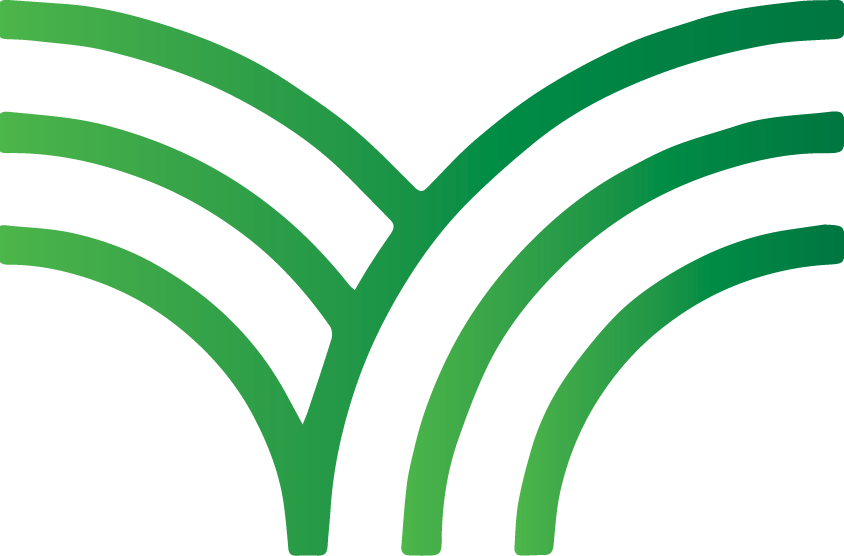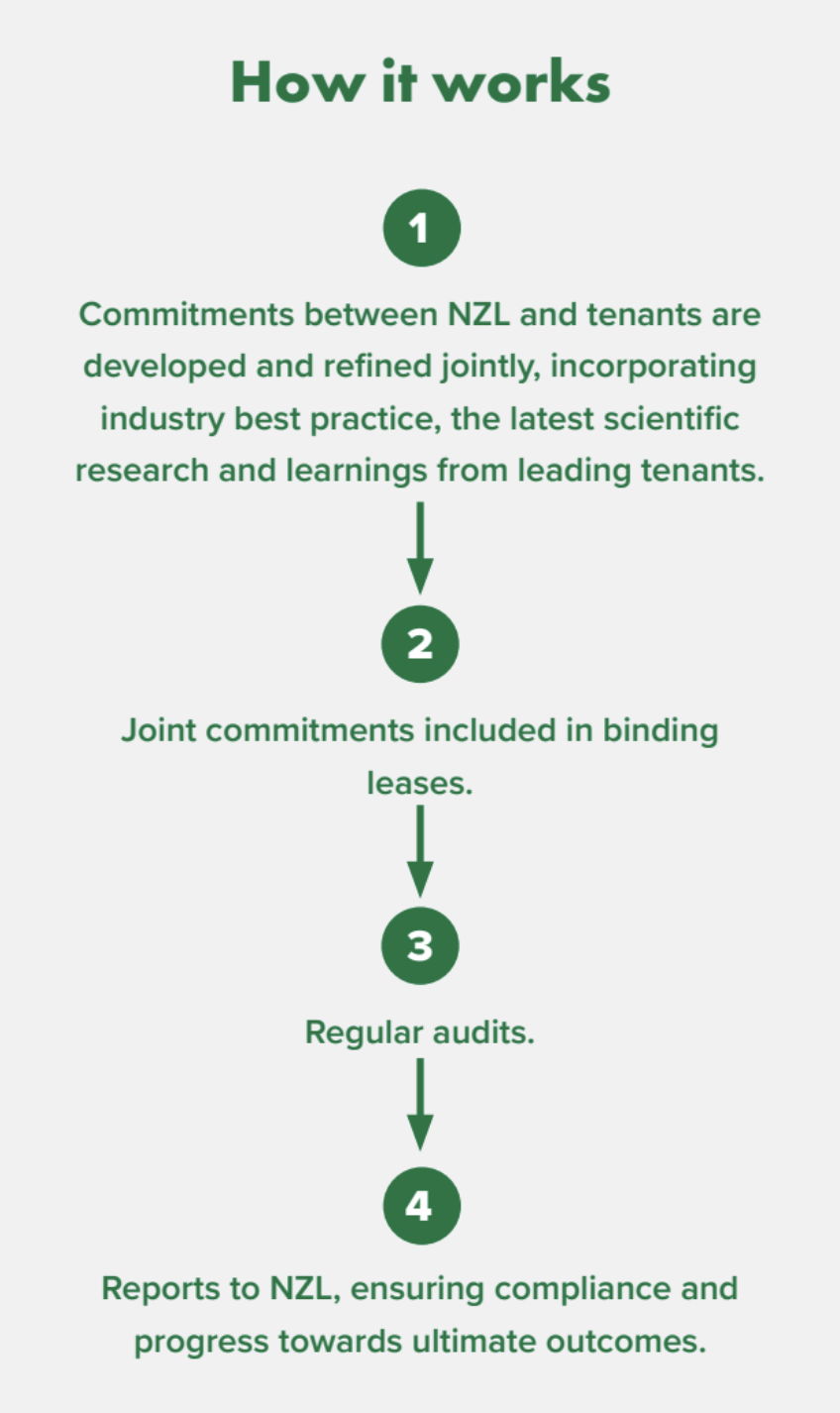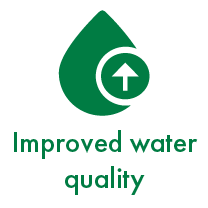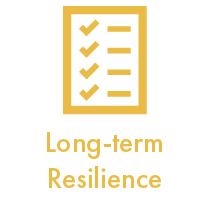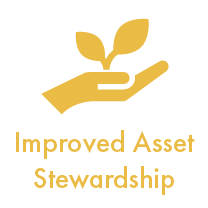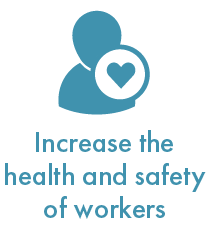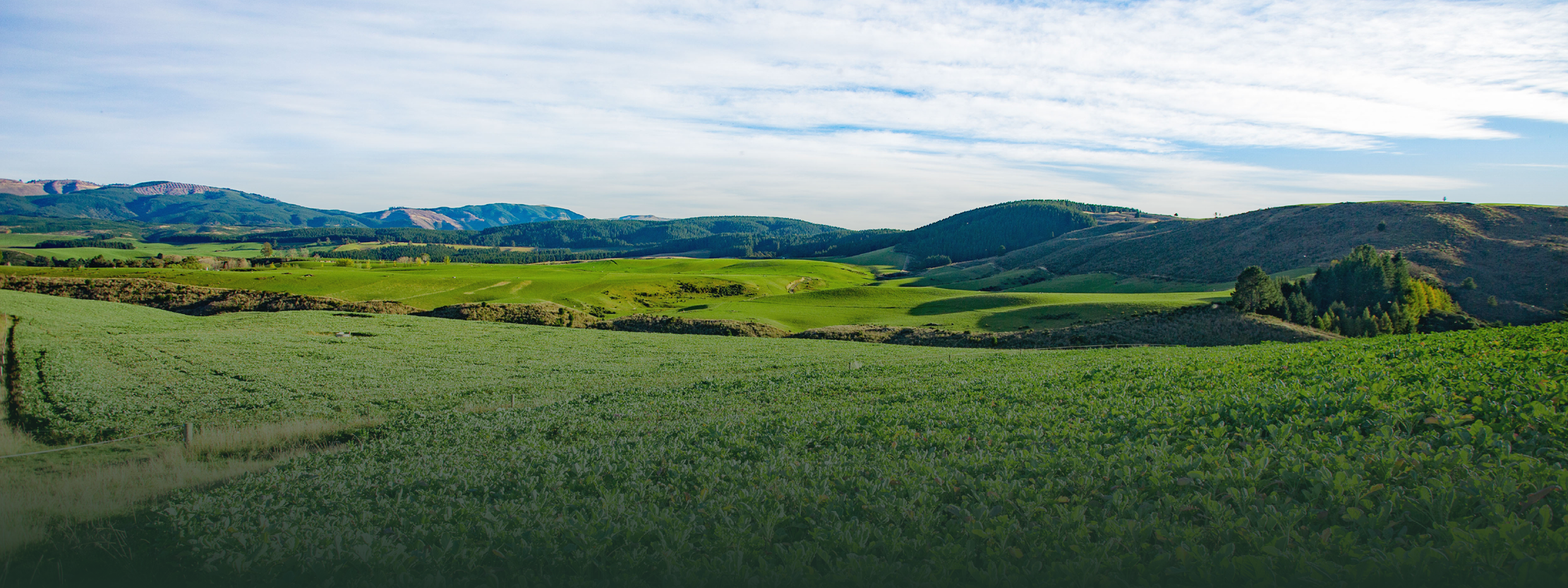
To ensure long-term success NZL has a holistic approach to
Sustainability
Safeguarding Our Land’s Endurance
Land is essential for life. It’s the source of most of our food, it underpins half our export earnings and it supports families, iwi, jobs, companies and communities. Productive land for agriculture is shrinking. In just two years, from 2017 - 2019, the land used for agriculture and horticulture in New Zealand decreased by 208,000 hectares. When land is enduring, life is enduring: environmentally, socially and economically.
The New Zealand Rural Land Company is here to enable enduring land for life. We are building a portfolio of highly-productive land and partnering with skilled primary producers. We are enabling up-and-coming farmers to thrive as well as opening up ways for older farmers to unlock the value of their land before retirement. We are setting exacting standards in our approach to land management, animal welfare, human resources and governance, ensuring the land we own and our farming partners of today will be safeguarded to support the producers of tomorrow.
That’s why we developed a commitment that sits at the core of our business approach.
It’s binding, written into our contractual relationship with our partners, and it ensures we become a positive, market-leading force for exceptional land stewardship and sustainability.
Climate Related Disclosures
Our Programme
It’s important we make smart decisions about how we use our land, what we use it for and how we take care of it. Farms are complex natural systems where the performance of one component, such as sheep or dairy cattle, is influenced by others, including soil fertility, quality feed or the training, competence and morale of farm staff. For us, enduring land management is achieved through goals and actions in four connected areas: environmental, economic, social and animal welfare. A fifth area, governance, ensures oversight and management of these goals in each on-farm area, and the monitoring and measurement of performance. These goals and the specifics related to their achievement are included in our partnership agreements with our tenants. As the land owners, NZ Rural Land Company believes smart decisions start with who we work with. The bar is high because our expectations are also high, but there is no shortage of quality candidates. We are confident our farms are in safe hands, because the defining factors for enduring land for life are in place, practical, meaningful and measurable.
The Framework
Our multi-dimensional approach ensures we are setting the standard in food and energy production, building endurance and sustainability
Environmental Sustainability
✓ Soil Health
✓ Water Quality
✓ Biodiversity
✓ Emissions reduction per
unit of production
Protecting and enhancing the environment has a positive impact on the sustainability of our assets and our planet. Our environmental initiatives are focused on protecting and enhancing soil health, water quality and biodiversity, along side reducing greenhouse gas emissions on aper-unit-of-production basis.
Economic
Resilience
✓ Land Selection
✓ Partnering with tenants
✓ Creating a virtuous circle of
growth, investment, job
creation, community
opportunities
Economic success and prosperity is an essential part of sustainability: it ensures our long-term viability, enabling us to continue achieving our other sustainability aims. It’s vital to motivate partners and their teams, to create opportunity, foster growth, reduce inequality, improve health, and increase investment in research and development. This long-term economic success is in turn dependent on the long-term health of our core asset: the land. A long-term view, long-term leases and careful selection of quality tenants creates a virtuous circle of growth, investment in innovation, creation of jobs and increased opportunities for the community.
Social Integrity
✓ Care of people
✓ Health & Safety
✓ Warm, safe living conditions
✓ Enabling career and personal
growth
✓ Fair pay
People are one of the most important elements of any business. We partner with tenants who prioritise the economic, career and personal growth of their people while providing safe, warm, and healthy work and living environments. We ensure this by careful selection of quality tenants committed to the wellbeing of their workforce.
Animal Welfare Responsibility
✓ Five freedoms
✓ Prioritising animal welfare
✓ Nutrition & care
✓ Adequate shelter
Along with land, people and animals are an integral part of our ecosystem. Prioritising animal wellbeing has numerous positive outcomes, for the animals themselves as well as in economic prosperity. We and our partner stake pride in their animal welfare practice, which prioritise good nutrition, adequate shelter, and care for their physical and psychological wellbeing.
Mana Whenua
✓ Prioritising relationships with
mana whenua/te ahi kaa
Prioritising relationships with mana whenua or te ahi kaa is critcal to our long term success. Mana whenua/te ahi kaa have an intergenerational role as kaitiaki and rangatira, and hold significant mātauranga that helps to understand how to maintain the mauri of the land. Genuine relationships with mana whenua/ahi kaa and working collaboratively towards ensuring the wellbeing of the land will enhance our Enduring Land Management outcomes.
Governance
Oversight and management of goals; skills and comitment to “Enduring Land for Life” vision. Strength and diversity.
We know that the success of any strategy starts with the tone at the top, and we value strong and diverse governance. Having the right mix of skills and experience ensures NZL has the capability and vision needed to achieve our mission.
Environmental Sustainability: Focus Areas
Each asset has focus areas and audited/measured initiatives within that are specific to the asset type and area. Each focus area and initiative are designed to drive an ultimate outcome.
Best-practice irrigation efficiency
Ensure irrigation systems use water as efficiently as possible, ensuring plant demands are met while the risk of leaching and runoff is minimised
Focus Area
All new irrigation systems will meet Irrigation New Zealand (INZ) design and installation COPs and standards;
Irrigation systems will be maintained and operated to ensure optimal efficiency with their performance;
Timing and depth of irrigation is appropriate for crop requirements and is supported by soil moisture monitoring, soil water budgets and climatic information;
Staff are trained in the operation, maintenance and use of irrigation systems; and,
All water meters accurately measure water use
Audited/Measured Initiatives
Ultimate outcome
Best-practice nutrient usage
Using nutrients efficiently minimises nutrient losses to water. Ensure nutrient losses remain in compliance with consented nitrogen loss limits.
Focus Area
Nitrogen, phosphorus and sediment losses from farming activities are minimised using all available loss mitigation measures;
Proactively manage the amount, timing and application of fertiliser inputs to match the predicted plant requirements and minimise nutrient losses;
Store and load fertiliser to minimise the risk of spillage, leaching and losses into water bodies; and ,
Demonstrate plans to minimise nutrient and sediment losses from winter grazing of forage crops.
Audited/Measured Initiatives
Ultimate outcome
Soil quality optimisation
Maintaining or improving the physical and biological structure of soils minimises the movement of sediment, phosphorous and other contaminants into waterways.
Focus Area
Employ farming practices that do not exacerbate erosion;
Implement farming practices which optimise water infiltration into the soil profile while minimising water runoff, sediment loss and erosion.
Audited/Measured Initiatives
Ultimate outcome
Effluent Excellence
Ensuring animal effluent and solid animal waste is managed well, minimising nutrient leaching and runoff.
Focus Area
All effluent systems meet industry codes of practice or an equivalent standard;
Timing and rate of application of effluent and solid waste to land is managed in order to minimise the risk of contamination of groundwater or surface water bodies;
Suitable storage is available to store animal effluent and wash-down water when soil conditions are unsuitable for application or appropriate practices are in place to manage insufficient storage while infrastructure is upgraded; and,
Staff are trained in the operation, maintenance and use of effluent storage and application systems and keep accurate records
Audited/Measured Initiatives
Ultimate outcome
Biodiversity protection and enhancement
Wetlands, riparian areas and the margins of surface water bodies are managed to avoid damage to the bed and margins of the water body, and to avoid the direct input of nutrients, sediment and microbial pathogens. We also ensure in-stream biodiversity values are protected and enhanced.
Focus Area
Stock are excluded from water bodies in accordance with regional council rules or any resource consents;
Vegetated riparian margins of sufficient width are maintained to minimise nutrient, sediment and microbial pathogen losses to water bodies;
Farm tracks, gateways, water troughs, self-feeding areas, stock camps, wallows and other farming activities that are potential sources of sediment, nutrient and microbial loss are located so as to minimise the risk to surface water quality;
Mahinga Kai values are protected as a result of measures taken to protect and enhance water quality and stream health; and,
All areas of indigenous biodiversity on the farm are identified, protected and enhanced, with priority given to springs, wetlands, and spring-fed streams.
Audited/Measured Initiatives
Ultimate outcome
Mahinga Kai
We strive to uphold Mahinga Kai values.
Focus Area
Mahinga Kai values are taken into account when implementing all other Farm Environmental Plan (FEP) objectives;
All areas of indigenous vegetation are managed to avoid adverse effects on mahinga kai values of surface water bodies and in accordance with regional/district council vegetation clearance rules or any granted resource consent;
Opportunities for additional plantings of indigenous vegetation that recognises mahinga kai values of surface water bodies are identified, and plantings are implemented and managed in accordance with regional council guidelines for riparian planting;
Farming activities are undertaken in ways that minimise adverse effects on indigenous vegetation to recognise mahinga kai values of surface water bodies; and,
Pest plants are managed in accordance with regional council rules.
Audited/Measured Initiatives
Ultimate outcome
Hot spot management (silage and offal pits, farm rubbish)
We ensure the number and location of pits are managed to minimise risks to health and water quality. Other hotspots are managed to minimise environmental damage and risks.
Focus Area
All on-farm silage, offal pit and rubbish dump discharges are managed to avoid direct discharges of contaminants to groundwater or surface water;
Rubbish, fuel and other hot spots are managed to minimise environmental damage.
Audited/Measured Initiatives
Ultimate outcome
Precise water use
Use water efficiently, ensuring that actual use of water is monitored and efficient.
Focus Area
Actual water use is efficient for the end use.
Audited/Measured Initiatives
Ultimate outcome
Greenhouse gas reduction
Manage, measure and mitigate farm greenhouse gas emissions, including methane, nitrous oxide and carbon dioxide.
Focus Area
Calculate net farm greenhouse gas emissions using a recognised method;
Identify relevant practices and prepare a plan with actions to reduce greenhouse gas emissions; and,
Implement actions and practices to reduce GHG emissions and keep records of stock fertiliser and other farm data.
Audited/Measured Initiatives
Ultimate outcome
Ultimate outcome
Special Projects
Manage, measure and mitigate farm greenhouse gas emissions, including methane, nitrous oxide and carbon dioxide.
Focus Area
Additionally on an ad-hoc basis, NZL will undertake its own special projects with a focus on biodiversity, water quality or emission reduction focus.
Audited/Measured Initiatives

Economic Resilience: Focus Areas
Each asset has focus areas and audited/measured initiatives within that are specific to the asset type and area. Each focus area and initiative are designed to drive an ultimate outcome.
Well capitalised tenants
Tenants that are strong financially can endure volatile operating environments and continue to succeed and thrive.
Focus Area
Number of tenants with more than six times annual rental in equity.
Number of tenants with more than 1.4x EBITDA lease cover ratio.
Audited/Measured Initiatives
Ultimate outcome
Long-term partnerships (vs short-term)
We believe long-term leases encourage long-term thinkers and a commercial alignment of interest with regards to asset health and endurance.
Focus Area
Number of tenants with an initial lease term of 10 years.
Audited/Measured Initiatives
Ultimate outcome
Improving capital efficiency
An improvement in capital efficiency in the sector frees up capital to be used for more employment, increased R&D, more environmental initiatives and improved productivity encouraging and improving long-term sector prosperity & therefore endurance.
Focus Area
Number of farms that we own and lease vs previously owned and operated (%).
Audited/Measured Initiatives
Ultimate outcome

Social Integrity: Focus Areas
Each asset has focus areas and audited/measured initiatives within that are specific to the asset type and area. Each focus area and initiative are designed to drive an ultimate outcome.
Focus Area
Health and Safety excellence
Comply with the Health and Safety at Work Act 2015 to ensure all people connected to the land are free from the risk of harm and can return home safely at the end of each day.
Number of leases that bind tenants to compliance with the Health and Safety at Work Act 2015;
Number of tenants that are compliant with the health and safety requirements under their leases.
Audited/Measured Initiatives
Ultimate outcome
Quality employment practices and environment
NZL manages and mitigates the risk of modern slavery.
Focus Area
Number / percentage of leases that bind to no modern slavery.
Audited/Measured Initiatives
Ultimate outcome
Healthy homes
NZL’s worker accommodation to comply with all healthy homes standards.
Focus Area
Number / percentage of compliant healthy homes in NZL’s portfolio.
Audited/Measured Initiatives
Ultimate outcome

Animal Welfare: Focus Areas
Each asset has focus areas and audited/measured initiatives within that are specific to the asset type and area. Each focus area and initiative are designed to drive an ultimate outcome.
Prioritise best practice animal welfare
Develop and maintain industry-leading animal welfare practices, including commitment to the Five Animal Freedoms.
Focus Area
Number of tenants complying with the Animal Welfare Act 1999 and ensuring animals have:
Proper and sufficient food and water;
Adequate shelter;
The freedom to express normal behaviour;
That appropriate physical handling is practiced; and,
Animals are protected from injury and disease.
Note: From FY24 these will be confirmed by independent property inspector and vet.
Audited/Measured Initiatives
Ultimate outcome

Mana Whenua: Focus Areas
Each asset has focus areas and audited/measured initiatives within that are specific to the asset type and area. Each focus area and initiative are designed to drive an ultimate outcome.
Priorities relationships with mana whenua / te ahi kaa
Focus Area
Audited/Measured Initiatives
Ultimate outcome
Coming soon…

Governance: Focus Areas
Each asset has focus areas and audited/measured initiatives within that are specific to the asset type and area. Each focus area and initiative are designed to drive an ultimate outcome.
Diverse, independent & experienced governance
Diverse and independent governance will help ensure strong risk management and better assessment of the wider business environment.
NZL has and will maintain governance that is independent and diverse by experience, age, gender, race and sector with directors and management who have a range of experience, translatable skills and a track record of establishing and implementing sustainability initiatives across a number of New Zealand businesses;
Focus Area
Number of independent vs non-independent directors;
Diversity of age and gender representation; and
Ethnicities represented.
Audited/Measured Initiatives
Ultimate outcome
Enduring Land: Scorecard
Coming Soon...

